Plaster mesh: types and scope
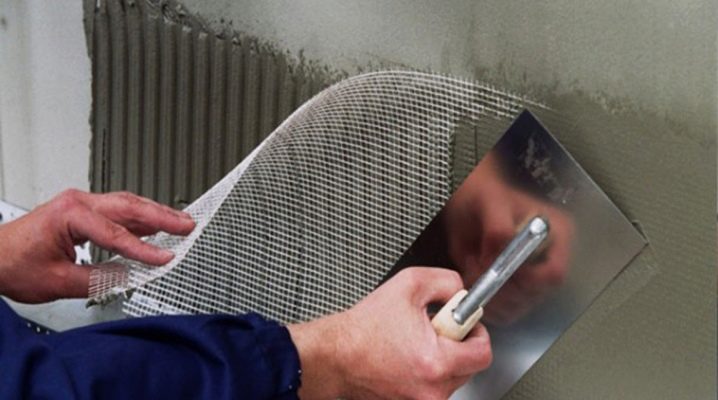
Repair, especially in secondary housing, is impossible without leveling all sorts of surfaces, be it walls, ceiling or floor. The most suitable option for leveling work is the use of plaster. This option provides not only leveling the surface, but also heat and sound insulation in the apartment, which is often an important factor for residents. For a more reliable and durable leveling layer, it is necessary to use a special plaster mesh. It not only fixes the leveling layer, but also prevents cracking and flaking of the material from the surfaces.


Peculiarities
First of all, it should be noted that plaster mesh is a versatile material that can be used at all levels of construction and decoration. So, for example, it can serve as a base for a wall panel, and can be used as an adhesion layer when leveling surfaces. The purpose and efficiency of its use will directly depend on the material from which this or that type of mesh is made, in addition, the design features of different types can play a significant role.


Most often, the plaster mesh is still used for outdoor work., it is an adhesion layer between the wall and the leveling layer of the plaster. The best adhesion occurs due to the structure of the cells, which are inherent in all mesh surfaces, it is thanks to them that the empty spaces are filled with the plaster mixture and its better adhesion to the surface to be leveled. And also it is thanks to this property that an even monolithic texture is obtained as a result.


Another feature and at the same time the advantage of this material is the ease of its installation, therefore, leveling the surface with plaster and mesh is subject to even an inexperienced repairman.
The solution seizes reliably, does not flow, as a result forms a reliable leveled surface.


Today, plaster mesh is used not only as an adhesion when leveling surfaces, but also in other repair work. So, a mesh is often used when installing a floor heating system. This material is a hitch for a concrete screed that covers the underfloor heating device. Wire mesh is often used to reinforce all kinds of structures, as well as in the construction of cages and corrals. The mesh can also be used as a protective covering material.


The selection of its material directly depends on the thickness of the required plaster layer. If serious leveling is not required, and the thickness of the facing layer will not exceed 3 centimeters, the use of a thin fiberglass mesh is quite appropriate. This is the cheapest option, which has the lowest weight, but at the same time it perfectly protects the surface from cracking.


If the thickness of the layer will lie in the range from 3 to 5 centimeters, it is more advisable to use a metal mesh. She will be able not only to strengthen the layer and prevent cracking, but also exclude the possibility of peeling off the coating. If the thickness of the required layer exceeds 5 centimeters, ideally it is worth abandoning the leveling in this way, since even the strongest sealing mesh will not be able to prevent the delamination of a too thick layer of material.


What is it for?
In order for the plastered surface to retain its original appearance for as long as possible, so that unnecessary peeling, cracking and other deformations of the material do not occur, it is necessary to adhere to a special technology during facing work.
The technology consists in the use of a special bonding layer between the rough wall and the plaster that will be applied to the selected surface. A special construction mesh is used as such a layer. It is she who is able to create a strong adhesion of walls and plaster, to exclude cracking and flaking.

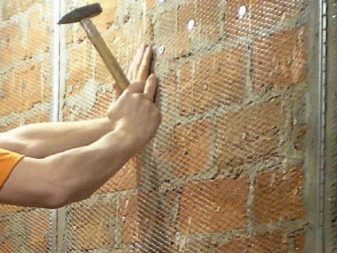
Before special nets made of various materials were used for external and internal work, a reinforcing layer of wooden rivers, as well as thin twigs, were used for repairs, later a reinforcing mesh made of metal began to be used. However, this material was quite heavy, its installation was laborious, so soon enough a replacement for metal was created and a plaster soft and light mesh made of plastic or fiberglass began to be used for finishing the facade. This option is easier to use, absolutely anyone can handle it, in addition, plastic and fiberglass are more convenient to cut and much lighter than wire options, however, as adhesion and strengthening of the finish, they are in no way inferior to other materials used.


The use of plaster reinforcing mesh is advisable when:
- It is necessary to create a special reinforcing frame that will not allow the facing layer to sprinkle or crack, which can occur during the drying process of the material.
- It is necessary to strengthen the bond between two materials that are too dissimilar in composition. So, for example, without the use of a bonding layer, it is impossible to hope for the successful plastering of materials such as chipboard, plywood, foam, since such materials have a texture too smooth to adhere to the leveling mixture.


- You can use one of the materials for the processing of joints or seams that are formed during the installation of any materials. For example, it is very convenient to handle joints between sheets of drywall or other sheet options.
- You can also resort to using mesh in the process of installing a waterproofing layer and insulation. A bonding layer is often needed between these layers and the sub-wall.


- The mesh structure is good and for better adhesion of materials during the installation of the underfloor heating system, it ensures the compaction of the concrete screed used in the installation.
- In addition, the use of a reinforcing layer is advisable during the installation of self-leveling floors. A binding and strengthening function will also be performed here.


Without reinforcement, the plaster layer may crack or begin to peel off, this is due to the fact that the drying process of a layer that is more than 2 centimeters thick is uneven, as a result of which zonal shrinkage of the material occurs, which can lead to cracking and other coating defects. The mesh layer provides a more uniform drying of the material due to the special structure of the honeycomb.
The material in the cells dries much faster and more evenly, preventing structural changes both during the repair process and after its completion.


It is also worth remembering that such strengthening is necessary not only for internal work, because the external walls are exposed to much greater negative effects. Changes in temperature, moisture, wind and other natural factors can spoil the cladding, therefore, with this kind of finishing, it is advisable to use a reinforced version, which is called in specialized stores - a facade or mesh for external finishing work.
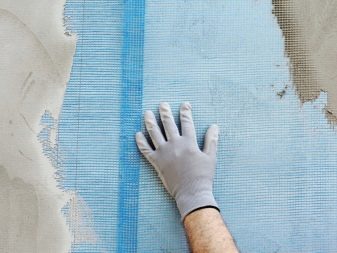
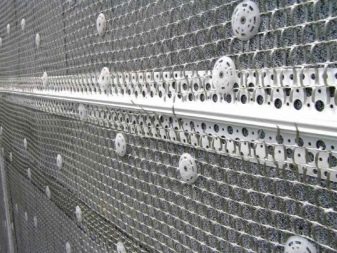
Types and characteristics
So, having determined why the plaster mesh is still needed, you can smoothly proceed to an analysis of its possible types, as well as the pros and cons of one or another option. Today the construction market offers a huge number of different types: serpyanka, wire, welded, polypropylene, painting, basalt, abrasive, plastic, metal, galvanized, glass mesh, steel, polymer, nylon, assembly. It is easy to get confused in them and choose the completely wrong one.





When choosing, first of all, you need to understand that all the options presented are divided into those that will be used for interior decoration, and those that can be used for external facades. They will differ in strength and materials of manufacture.


The most popular materials include:
- Plastic. This material is one of the most durable options. It can be used both as an interlayer in interior decoration and in exterior. This material is better than others for strengthening and leveling a brick wall. Thanks to this combination, plastic mesh can often be found under the name masonry mesh, since it is often used in the process of laying a wall. It allows not only to obtain a stronger adhesion of the bricks, but also to reduce the consumption of mortar, since the layer can be thinner.


- Another popular option is the versatile mesh., it can be used both for interior decoration and for exterior work. However, the universal option also includes three subgroups, the definition of which depends on the size of the cells. Determine: small, here the cell size is minimal and equal to the measurement of 6x6 mm; medium - 13x15 mm, as well as large - here the cell size already has dimensions of 22x35 mm. In addition, depending on the type and size of the cell, the scope of application of this or that option will be determined. So, small cells are the most suitable option for finishing walls and ceilings in residential premises. The middle mesh is usually made of polyurethane, which gives it additional rigidity and strength, and its scope is also limited to interior work. But large cells can be used for facing external surfaces.



- Most suitable for use on very embossed surfaces is fiberglass mesh... It is one of the most durable and easy-to-use versatile materials and is also suitable for both exterior and interior decoration work. Reinforcement using this type is the easiest due to the fact that fiberglass is not a brittle material at all, which means that even the most severe bends and deformations are not afraid of it. Thanks to this property, the material is almost the most popular option used in repair work. In addition, its cost is quite low and recoupment will occur very quickly.


- Polypropylene is another popular option. Due to its lightness, it is the best option for ceiling decoration. In addition, polypropylene is immune to various kinds of chemicals, which means it can be used in combination with a variety of mixtures and materials. Polypropylene meshes also come in several varieties. The type is determined by the size of the cells.


For example, the best option for ceiling decoration is plurima - a polypropylene mesh with 5x6 mm cells.
For the thickest layers, it is recommended to use a polypropylene version called armaflex. Thanks to reinforced nodes and cells with a size of 12x15, it is he who is able to withstand maximum loads and provide reinforcement even to the thickest and most embossed walls.
Polypropylene syntoflex acts as a universal finishing material; it can have a mesh size of 12x14 or 22x35.

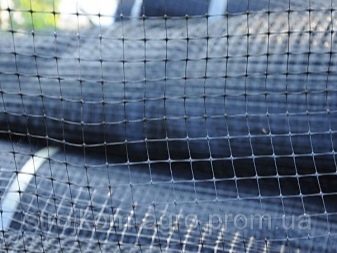


- The metal mesh does not lose its popularity. The sizes of the cells here can range from 5 mm to 3 centimeters, however, options with sizes 10x10 and 20x20 are more popular. The scope of application, however, is limited only to internal work, since the metal is extremely susceptible to external natural factors and can corny corny even under a layer of plaster, which can spoil the appearance of the facade, not to mention the fact that the material will lose its functionality.
- Galvanized mesh it can already be used for outdoor work, since it is not influenced by external factors.


Which one to use?
It would seem that there is nothing difficult in choosing and installing a particular mesh, you just have to choose an option for cost and purpose, but you should also pay attention to some of the nuances that can become a determining factor in choosing one or another option.
There are two main factors that will be decisive in choosing a mesh suitable for finishing. This is the material of the rough surface and the thickness of the plaster layer. This thickness will directly depend on the initial relief of the wall.

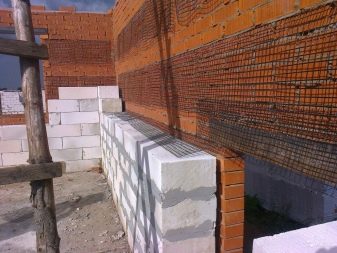
Depending on the material of the wall, the material of the mesh will be selected, as well as the method of its fastening. So, for cement, aerated concrete, concrete blocks and a brick wall, fiberglass or plastic is better suited, fastening occurs with dowels.
On wooden surfaces, fastening takes place using galvanized self-tapping screws. Metal bases, on the other hand, can exist only with a metal mesh, and the fastening process takes place by soldering with a welding machine.
For styrofoam and paint, as well as ceramic surfaces, it is better to use lightweight polypropylene, plastic or fiberglass.



Polypropylene often does not require additional fastening, it is easily attached to the wall by anchoring, however, it should be borne in mind that polypropylene cannot be used on too uneven surfaces, the so-called extreme, where a too thick layer of plaster is needed.
In the process of determining the thickness of the layer required to level the wall, you must use a special tool - the building level. With its help, it is necessary to find the lowest point and focusing on it, determine the thickness of the future plaster layer.
Depending on the measurements obtained, you can also choose one or another option.


So, for layers of plaster, lying in the range from 2 to 3 centimeters, it is advisable to use fiberglass, plastic or polypropylene. If the layer is more than 3 centimeters, it is recommended to use a metal mesh, having previously fixed it on the wall, otherwise the finished structure will turn out to be too heavy and will simply fall off under its own weight. In cases where the required layer becomes more than 5 centimeters, it is better to pay attention to other methods of leveling, for example, plasterboard cladding. This will significantly reduce the cost of dry mixes and significantly speed up the process.


Another significant factor when choosing a mesh will be its density. The higher the density, the better the reinforcement.
In terms of density, all grids can be divided into several groups:
- 50-160 grams per 1 sq. meter. The use of such a mesh is most common in the interior decoration of apartments. The differences in these options are only in the size of the cells, which in itself insignificantly affects the reinforcement indicators, which means that it depends only on the buyer's choice.


- 160-220 grams. Such meshes are an option for exterior decoration, they are not afraid of temperature changes and can withstand thicker layers of plaster, can be used on extreme walls and other structures, for example, on a stove. The size of the cells here, as a rule, is 5x5 mm or 1x1 centimeter.
- 220-300 grams - reinforced mesh options. They are able to withstand maximum loads and extreme conditions.
It is worth remembering that the higher the mesh density, the greater its cost.


Mounting
The nuances of installation will depend on the following factors: the material of the wall and its condition, the type of mesh, as well as the thickness of the plaster layer. Since fiberglass and metal are the most popular options today, it is worth considering fastening with these examples.


The technology of fastening a metal mesh and further plastering the surface is very simple. First you need to fix the metal cuts on the rough wall. This stage is necessary, since the metal has a fairly large dead weight, and with the applied plaster it will increase even more, which will entail the collapse of the structure. It is also worth remembering that in order to install the mesh on the external facade, it is necessary to purchase a galvanized version that will not be afraid of extreme conditions of existence.



In addition to the mesh itself, installation will require dowels and a special mounting tape. It is necessary to start attaching the mesh with measurements, this will help to cut off the necessary segments and cover the entire surface to be treated.
The next step is to drill holes for the dowels. The distance between the holes should be about 40-50 centimeters.
In addition, it is worth maintaining a checkerboard arrangement in the placement.


Installation starts from the upper corner near the ceiling, this is the most convenient and correct option. Screwing the screws into the wall and thereby securing the material, it is necessary to use special washers or mounting tape, the pieces of which must be placed under the screw head. In addition to self-tapping screws, it is possible to use dowel nails, which are simply driven into the wall, which significantly speeds up the process. The mesh can be fixed to a wooden surface with an ordinary furniture stapler.

If one layer of the metal mesh is not enough, the volume can be increased, in this case the overlap between the layers should be about 10 centimeters. After the entire surface to be treated is covered, you can proceed to plastering.
The fiberglass mesh can be stretched in several ways. It is a very convenient material for interior decoration and can be used by a craftsman with any experience. In addition, fiberglass has a low cost and is very easy to install.


When fastening, the upper corners will also serve as landmarks; it is better to start fastening from there. The first stage, as in the previous version, is the measurement of the surface that requires coating. Next, you need to cut the mesh into the required segments, if necessary, the joint should also leave an overlap of 10-15 centimeters.
When the necessary sections are cut out, you can simply attach the mesh in several places to the screws and this will be the first method, after which the necessary layer of plaster is applied on top of it.
For complete alignment, you can rely on plaster beacons.

In addition, it is possible to mount on the plaster itself. To do this, it is necessary to apply a thin layer of plaster on several zones, then attach a mesh and, as it were, press it into the mixture. After some time, when the structure has already set a little, you can apply the top leveling layer. As a result of this procedure, the mesh will be securely fixed and will no longer fall off, and the coating will not crack and will be stronger.

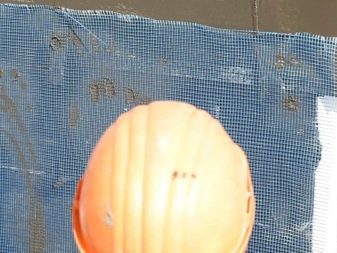
Helpful hints and tips
Here are some useful tips to help you choose and fix the plaster mesh correctly:
- Before fixing the material to the surface, it is necessary to remove all dust and dirt, and also to prime the wall. This will provide better adhesion during subsequent application of the material.
- Also, experts advise to degrease the material itself, this can be done with acetone or alcohol solutions. This will also provide better adhesion of the mixtures in the future.


- Particular attention should be paid to the area of the corners of the openings.Here the reinforcement must be strengthened, therefore, as a rule, an additional mesh 30 centimeters wide is attached.
- There are also special requirements of SNiP for plastering. For the most part, they relate to the thickness of the applied layer. So, for example, for gypsum plaster "Rotband" this value ranges from 5 to 50 mm, but for cement plaster this value is from 10 to 35 mm. But specifically, SNiP does not impose special requirements on the installation of the grid.


- Although SNiP does not impose special requirements on grids, they have their own GOSTs. The most popular are woven options with square cells GOST 3826-82, as well as metal GOST 5336-80. Therefore, when buying, it is necessary to request all available documents from the seller, only in this case you can get a really high-quality product that will fully meet the stated requirements.


- When choosing, the visual component is also important. The cells should be even and the same, there should also be no complaints about the quality of the weaving. When choosing a galvanized metal mesh, it is important to make sure that the coating is uniform and free of bald spots or gaps. If the choice of woven material is made, it is necessary to conduct a simple test for crease - if the coating is of good quality, it does not deform, and after creasing it will take its original shape.


- The thicker the layer, the thicker and stronger the mesh must be selected. It is always worth remembering that woven nets are suitable for coverings up to 3 centimeters thick, and metal ones are effective from 3 to 5 centimeters. If the thickness of the covering layer is greater, then it is better to use sheet materials for leveling the wall - this will save energy and reduce financial costs for dry mixes.
- For external work, you need to use a more durable reinforced model. It is better if the base is a metal with a density of at least 145 grams per square meter. meter, and most importantly - the selected mesh must have a galvanized coating that will protect the surface from temperature changes and moisture.
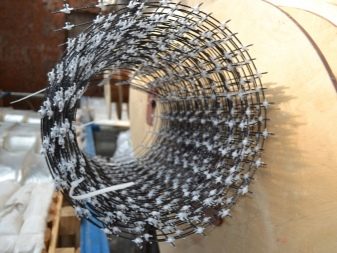

- If a concrete-based mixture is chosen for plastering the surface, then in no case should a plastic reinforcing fabric be used, since after some time the cement will corrode it.
- When calculating the required number of dowels, you can use a simple rule. For 1 sq. meters, as a rule, 16-20 pieces are used.


For information on how to install a plaster mesh, see the next video.













The comment was sent successfully.